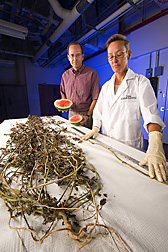This page has been archived and is being provided for reference purposes only. The page is no longer being updated, and therefore, links on the page may be invalid.
|
Read the magazine story to find out more. |
|
|
|
|
Researchers Identify Cause of Watermelon Vine Decline
By Alfredo FloresNovember 8, 2007
With popular and nutritious watermelon now battling a new plague called watermelon vine decline, Agricultural Research Service (ARS) scientists in Fort Pierce, Fla., are trying to pinpoint the cause of the disease and find ways to control it.
A crippling plant disease, watermelon vine decline (WVD) has made a serious economic impact since first being seen in Florida in May 2003. So far, it has been limited to the Sunshine State, but growers fear it could spread anywhere watermelons are commercially grown. Research efforts are being led by plant pathologist Scott Adkins, who's in the ARS Subtropical Plant Pathology Research Unit at Fort Pierce.
Symptoms of WVD include interior browning of the fruit rind, rapid vine collapse and death just before harvest. Yield losses totaled more than $60 million in 2005, relegating Florida watermelon producers to the No. 2 spot, behind Texas.
Plant pathologist Benny Bruton has worked with Adkins since the initial stages of WVD research, and plant pathologist Shaker Kousik joined the effort in November 2005. Bruton is at the ARS South Central Agricultural Research Laboratory in Lane, Okla., while Kousik is at the ARS U.S. Vegetable Laboratory in Charleston, S.C.
Bacteria, fungi and non-biological factors had been previously eliminated as the cause of WVD by other researchers. Then Adkins—in collaboration with Susan Webb, a University of Florida entomologist, and Carlye Baker, a plant pathologist with the Florida Department of Agriculture and Consumer Services, Division of Plant Industry—determined that the novel ipomovirus named squash vein yellowing virus is the causal agent. The host range of squash vein yellowing virus appears to be limited to the Cucurbitaceae family, with the most dramatic symptoms occurring on squash and watermelon.
It had been known for some time that the principal insect pests on watermelons in Florida were aphids, rindworms, whiteflies and thrips, but it took two years of research to determine that squash vein yellowing virus, transmitted by the silverleaf whitefly, was responsible for WVD.
Screening of watermelon germplasm for resistance to squash vein yellowing virus in greenhouse trials in Fort Pierce and field trials with University of Florida scientists has yielded promising results.
Read more about this research in the November/December 2007 issue of Agricultural Research magazine.
ARS is the U.S. Department of Agriculture’s chief scientific research agency.

